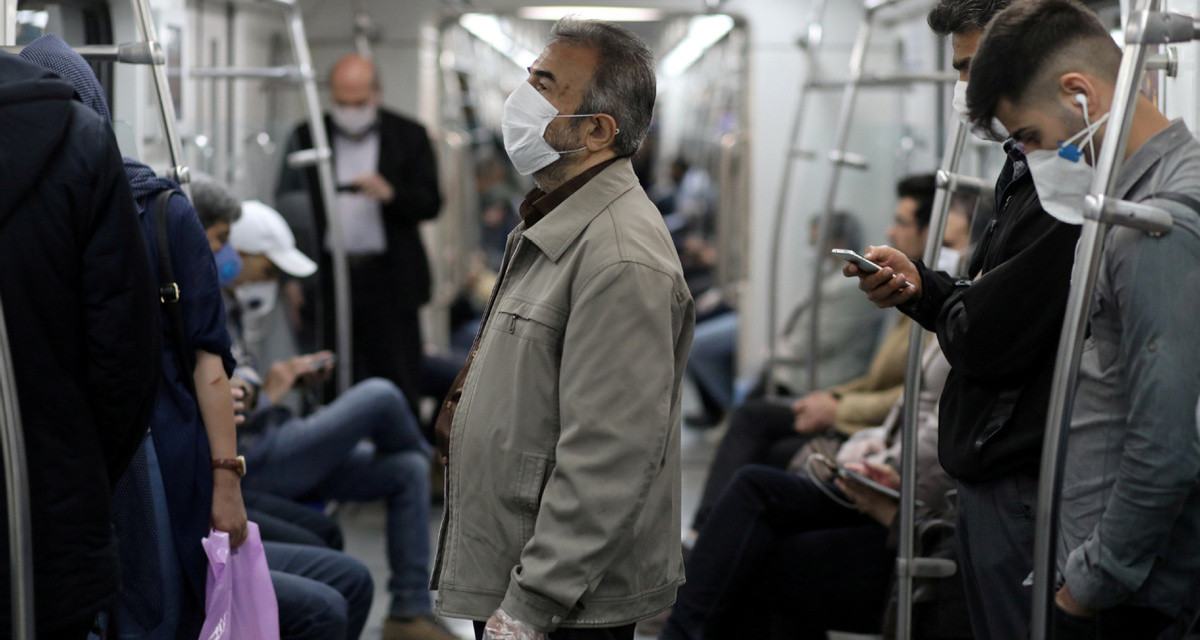Masked passengers on the Tehran metro, May 20, 2020
Continuing to defy a resurgent Coronavirus, Iran’s Government has said staff are returning to office work and mosques will reopen on a daily basis.
Two-thirds of Government employees had worked from home at the height of the crisis, which has officially claimed 7,734 lives with the unofficial toll likely to be much higher.
Mosques were reopened more than three weeks ago, amid the Government’s phased lifting of restrictions since April 11.
See Iran Daily, May 3: Coronavirus — Mosques Reopened in 132 Cities
President Hassan Rouhani said on Saturday, “Doors to mosques across the country will open to the public for daily prayers.” He also declared that shopping malls can now stay open after 6 pm.
Last month the Government began the reopening of “low-risk” businesses. This expanded to restaurants last week after the end of Ramadan. Universities are scheduled to resume classes on June 6.
Daily Cases Near 3,000
The official number of cases, which had fallen to 803 on May 2, reached 2,819 on Friday. Another 2,282 were recorded on Saturday, bringing the total since late February to almost 150,000.
Medics, analysts, and even Iranian officials have said the figures are underreported. A Parliamentary research group assessed earlier this month that the true number is about double that of the Health Ministry count.
Alireza Zali, head of the oronavirus Taskforce of Tehran, told state TV that the situation in the capital is “still not favorable”. He asked the public for a “more serious observance” of social distancing.
With Iran in economic crisis, the Supreme Leader has called for fulfilment of his declaration of “A Surge in Production”, saying that this will “neutralize” Coronavirus.
Even as cases resurged this month, President Rouhani proclaimed “success” in containing the virus, with three phases of re-opening and a fourth to follow.
See Iran Daily, May 13: Coronavirus — Rouhani Declares Success as Death Toll Reaches 6,733
A Health Ministry spokesman said on Saturday that Khuzestan Province in southwest Iran is still classified as “red” zone, and seven of Iran’s 30 other provinces are at risk.


Iran’s Interior Ministry says that around 200 people were killed in the 2019 unrest, 20% of whom were shot by unknown assailants: https://www.bloombergquint.com/politics/iran-tallies-up-deaths-six-months-after-protest-crackdown
A full breakdown will be given in the next few days.
Rastgoo,
It only officials a few hours to manufacture the numbers in the 2009 elections, so unclear why it should take more than six months to manufacture the numbers here.
S.
It only took Iranian officials a few hours to manufacture the numbers in the June 2009 election, so unclear why it has taken more than six months to manufacture the numbers here….
So Bloomberg RE-REPORTS the KOS-SHER (bullshit)that mullahs blurt out. Does that make it true? Maybe only in your twisted criminal mind. You people are so far deep in this shit that no longer realize how demented you have become.